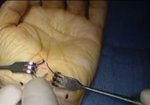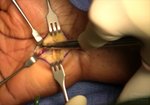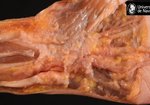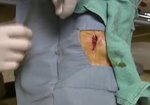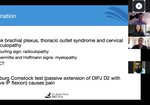Video Player is loading.
Current Time 0:00
/
Duration 0:00
Loaded: 0%
0:00
Stream Type LIVE
Remaining Time -0:00
1x
- 0.5x
- 0.75x
- 1x, selected
- 1.25x
- 1.5x
- 1.75x
- 2x
- Chapters
- descriptions off, selected
- captions settings, opens captions settings dialog
- captions off, selected
This is a modal window.
Beginning of dialog window. Escape will cancel and close the window.
End of dialog window.
10 seconds
Playback speed
This is a modal window. This modal can be closed by pressing the Escape key or activating the close button.
Revision Carpal Tunnel Release in a Case of Proximal Median Nerve Hematoma Injury and Mild Compression - Standard
7,219 views
March 19, 2012
<!--Code is buggy. I cannot use <br> or </br> and instead using </strong> for line ...
read more ↘ breaks-->
<strong>High Definition Standard Version - https://vimeo.com/38657362
High Definition Extended Version - https://vimeo.com/38657363
</strong>
<strong>Education Website - http://nervesurgery.wustl.edu
Video Library - https://vimeo.com/user6062882
</strong>
<strong>Revision Carpal Tunnel Release in a Case of Proximal Median Nerve Hematoma Injury and Mild Compression</strong>
Standard Version (7.120301.120229)
</strong>
Complications following carpal tunnel release are uncommon with patients experiencing persistent, recurrent, or new symptoms in the post-operative period. There are multiple etiologies for recurrent carpal tunnel syndrome, which can include traction neuropathy. This is when the epineurium of the median nerve adheres to the surrounding scar tissue and prevents normal nerve gliding leading to traction neuritis. This patient lost median nerve function due to a hematoma compression that developed from a peripherally inserted central catheter in the arm. While this patient did not have sensory function, he was recovering pronator teres and flexor carpi radialis function. For any possibility of sensory recovery, a revision carpal tunnel release was performed to ensure a complete release and mild compression of the median nerve was observed. The median motor function was augmented with a reverse end-to-side nerve transfer. This case is also a demonstration of bifid median nerve in the hand.
</strong>
Table of Contents
00:10 Orientation
00:15 Incision
00:32 Superficial Exposure
01:12 Identifying and Releasing the Flexor Retinaculum
01:44 Identifying the Carpal Tunnel
02:15 Identifying and Releasing the Tendinous Leading-edge of the Hypothenar Muscles
02:38 Identifying the Median Nerve Proximally
03:01 Completing the Release of the Flexor Retinaculum
03:29 Releasing the Median Nerve from Surrounding Scar Tissue
03:47 Identifying the Bifurcation of the Median Nerve
04:22 Longitudinal Neurolysis of the Median Nerve
04:51 Transverse Neurolysis of the Median Nerve
05:14 Application of an Adhesion Barrier on the Median Nerve
</strong>
Narration: Susan E. Mackinnon
Videography: Andrew Yee
</strong>
Terms of Use and Private Policy: nervesurgery.wustl.edu/pages/termsofuse.aspx
↖ read less
read more ↘ breaks-->
<strong>High Definition Standard Version - https://vimeo.com/38657362
High Definition Extended Version - https://vimeo.com/38657363
</strong>
<strong>Education Website - http://nervesurgery.wustl.edu
Video Library - https://vimeo.com/user6062882
</strong>
<strong>Revision Carpal Tunnel Release in a Case of Proximal Median Nerve Hematoma Injury and Mild Compression</strong>
Standard Version (7.120301.120229)
</strong>
Complications following carpal tunnel release are uncommon with patients experiencing persistent, recurrent, or new symptoms in the post-operative period. There are multiple etiologies for recurrent carpal tunnel syndrome, which can include traction neuropathy. This is when the epineurium of the median nerve adheres to the surrounding scar tissue and prevents normal nerve gliding leading to traction neuritis. This patient lost median nerve function due to a hematoma compression that developed from a peripherally inserted central catheter in the arm. While this patient did not have sensory function, he was recovering pronator teres and flexor carpi radialis function. For any possibility of sensory recovery, a revision carpal tunnel release was performed to ensure a complete release and mild compression of the median nerve was observed. The median motor function was augmented with a reverse end-to-side nerve transfer. This case is also a demonstration of bifid median nerve in the hand.
</strong>
Table of Contents
00:10 Orientation
00:15 Incision
00:32 Superficial Exposure
01:12 Identifying and Releasing the Flexor Retinaculum
01:44 Identifying the Carpal Tunnel
02:15 Identifying and Releasing the Tendinous Leading-edge of the Hypothenar Muscles
02:38 Identifying the Median Nerve Proximally
03:01 Completing the Release of the Flexor Retinaculum
03:29 Releasing the Median Nerve from Surrounding Scar Tissue
03:47 Identifying the Bifurcation of the Median Nerve
04:22 Longitudinal Neurolysis of the Median Nerve
04:51 Transverse Neurolysis of the Median Nerve
05:14 Application of an Adhesion Barrier on the Median Nerve
</strong>
Narration: Susan E. Mackinnon
Videography: Andrew Yee
</strong>
Terms of Use and Private Policy: nervesurgery.wustl.edu/pages/termsofuse.aspx
↖ read less
Comments 11
Login to view comments.
Click here to Login



